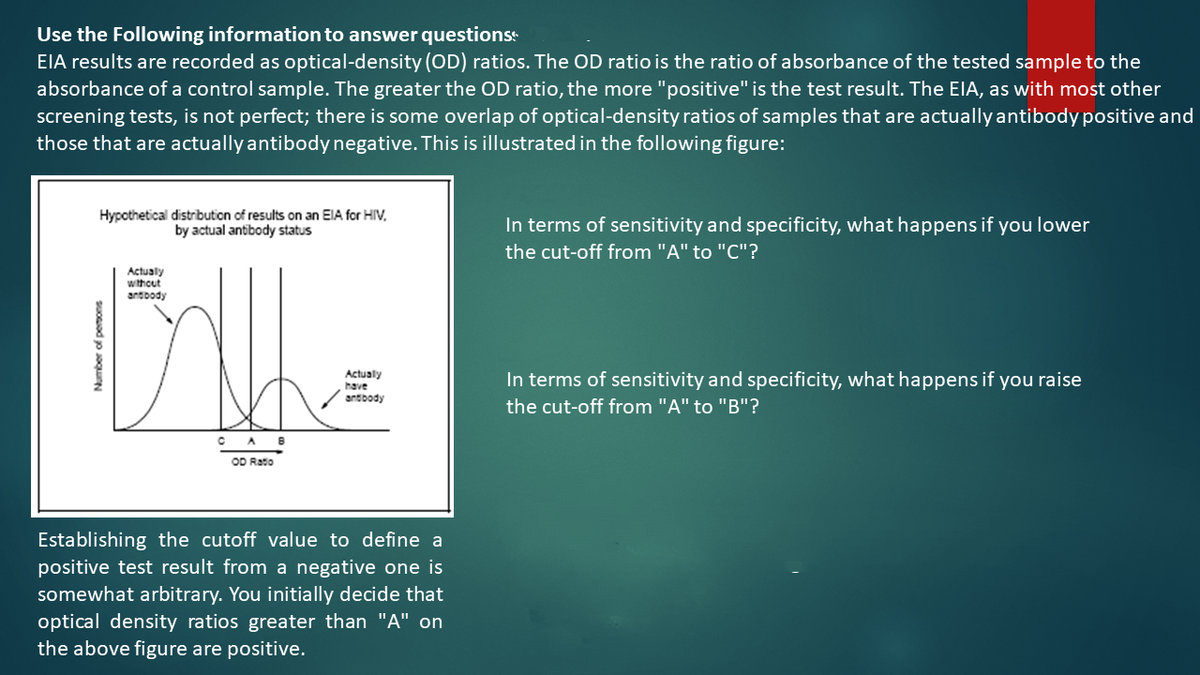Use the Following information to answer questionse EIA results are recorded as optical-density (OD) ratios. The OD ratio is the ratio of absorbance of the tested sample to the absorbance of a control sample. The greater the OD ratio, the more "positive" is the test result. The EIA, as with most other screening tests, is not perfect; there is some overlap of optical-density ratios of samples that are actually antibody positive and those that are actually antibody negative. This is illustrated in the following figure: Hypothetical distribution of results on an EIA for HIV, by actual antibody status In terms of sensitivity and specificity, what happens if you lower the cut-off from "A" to "C"? Actualy without antbody Actualy have antbody In terms of sensitivity and specificity, what happens if you raise the cut-off from "A" to "B"? OD Rato Mumber of persons
Use the Following information to answer questionse EIA results are recorded as optical-density (OD) ratios. The OD ratio is the ratio of absorbance of the tested sample to the absorbance of a control sample. The greater the OD ratio, the more "positive" is the test result. The EIA, as with most other screening tests, is not perfect; there is some overlap of optical-density ratios of samples that are actually antibody positive and those that are actually antibody negative. This is illustrated in the following figure: Hypothetical distribution of results on an EIA for HIV, by actual antibody status In terms of sensitivity and specificity, what happens if you lower the cut-off from "A" to "C"? Actualy without antbody Actualy have antbody In terms of sensitivity and specificity, what happens if you raise the cut-off from "A" to "B"? OD Rato Mumber of persons
Mathematics For Machine Technology
8th Edition
ISBN:9781337798310
Author:Peterson, John.
Publisher:Peterson, John.
Chapter29: Tolerance, Clearance, And Interference
Section: Chapter Questions
Problem 16A: Spacers are manufactured to the mean dimension and tolerance shown in Figure 29-12. An inspector...
Related questions
Concept explainers
Equations and Inequations
Equations and inequalities describe the relationship between two mathematical expressions.
Linear Functions
A linear function can just be a constant, or it can be the constant multiplied with the variable like x or y. If the variables are of the form, x2, x1/2 or y2 it is not linear. The exponent over the variables should always be 1.
Question
Please solve very soon completely all parts

Transcribed Image Text:Use the Following information to answer questionss
EIA results are recorded as optical-density (OD) ratios. The OD ratio is the ratio of absorbance of the tested sample to the
absorbance of a control sample. The greater the OD ratio, the more "positive" is the test result. The EIA, as with most other
screening tests, is not perfect; there is some overlap of optical-density ratios of samples that are actually antibody positive and
those that are actually antibody negative. This is illustrated in the following figure:
Hypothetical distribution of results on an EIA for HIV,
by actual antibody status
In terms of sensitivity and specificity, what happens if you lower
the cut-off from "A" to "C"?
Actualy
without
antibody
Actualy
In terms of sensitivity and specificity, what happens if you raise
have
antbody
the cut-off from "A" to "B"?
CA
OD Ratio
Establishing the cutoff value to define a
positive test result from a negative one is
somewhat arbitrary. You initially decide that
optical density ratios greater than "A" on
the above figure are positive.
suOGod o oqunN
Expert Solution
This question has been solved!
Explore an expertly crafted, step-by-step solution for a thorough understanding of key concepts.
This is a popular solution!
Trending now
This is a popular solution!
Step by step
Solved in 2 steps

Knowledge Booster
Learn more about
Need a deep-dive on the concept behind this application? Look no further. Learn more about this topic, statistics and related others by exploring similar questions and additional content below.Recommended textbooks for you

Mathematics For Machine Technology
Advanced Math
ISBN:
9781337798310
Author:
Peterson, John.
Publisher:
Cengage Learning,

Glencoe Algebra 1, Student Edition, 9780079039897…
Algebra
ISBN:
9780079039897
Author:
Carter
Publisher:
McGraw Hill

Mathematics For Machine Technology
Advanced Math
ISBN:
9781337798310
Author:
Peterson, John.
Publisher:
Cengage Learning,

Glencoe Algebra 1, Student Edition, 9780079039897…
Algebra
ISBN:
9780079039897
Author:
Carter
Publisher:
McGraw Hill